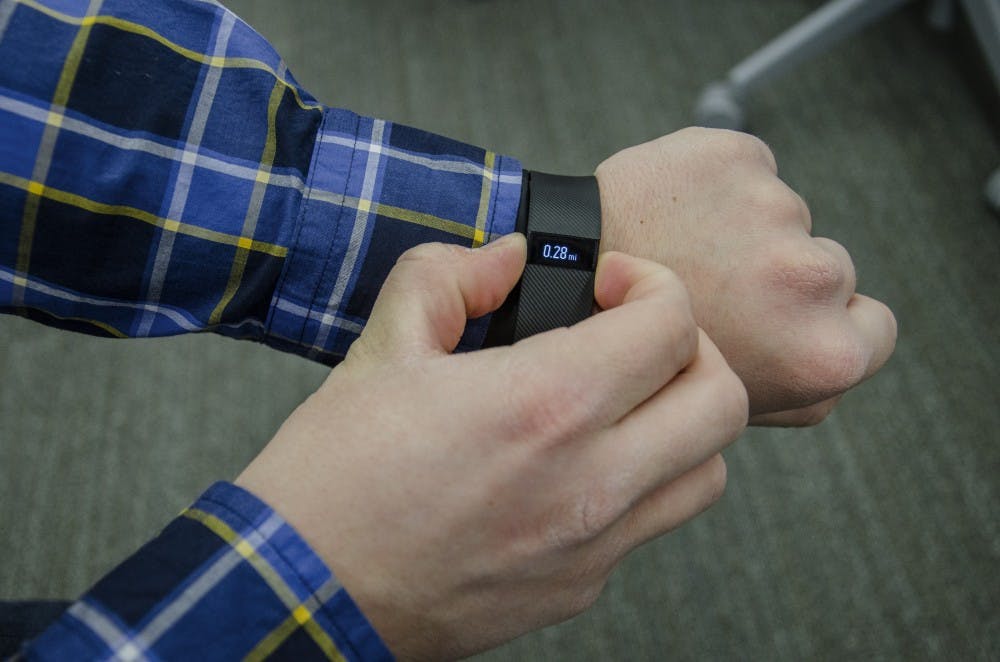Everyday user:
Zip- $59.95 Tracks steps, distance and calories burned. Clips onto an article of clothing.
One- $99.95 All of Zip’s features but it also tracks stairs climbed and tracks sleep patterns. Also has an alarm clock. Clipped onto an article of clothing.
Flex- $99.95 Same features as One, but is worn like a watch.
Charge- $129.95 Same features as Flex, but this watch also has caller ID and a clock.
Active user:
Charge HR- $149.95 Has all of the same abilities as the Charge, but can also monitor the users heart rate.
Performance:
Surge- $249.95 The Surge has all of the features that the Charge HR has, but also offers GPS tracking, music control and notifications.
A silent alarm goes off, and Jessica Adkisson is up and out of bed without disturbing her boyfriend’s sleep.
Adkisson, a graduate student studying sport administration, loves the silent, vibrating alarm clock feature on her Fitbit Charge.
Since 2011, the Fitbit has been tracking fitness habits in and out of the gym. Newer models like the Charge and the Flex have changed some student’s daily routines.
The Fitbit records sleep patterns, noting when the user is restless, awake or in deep sleep. It also counts calorie intake, how many steps the user takes in a day, how many stairs they've climbed and how many calories they've burned while working out.
The user interface is easy to use, said Fitbit wearer and sophomore physical education major, Miranda Kuehl.
Kuehl wears the Flex. As a middle-range model, the flex counts steps, calories and distance, tracks sleep, has the silent alarm and can track workouts.
Middle and high range models of the Fitbit track sleep patterns. The device detects movement and tracks whether the user is in deep, restful sleep or if they are awake and moving around.
Kuehl believes that this feature is one of the device’s best.
“When I first got [my Fitbit] I was like ‘Oh, every night will be pretty similar or show similar things,’” she said. “But since I’ve had it every night has been different.”
The Fitbit records user’s sleep patterns each night, and stores the information on a graph.
“You can wake up in the morning and feel like you didn’t get very good sleep and then you can look and see,” Kuehl said. “‘Oh, I was awake like 11 times’ or ‘I was restless for 30 minutes in my sleep last night.’”
The Fitbit can connect with the user’s phone or the Fitbit website, where it stores its data and allows the user to set fitness goals.
The app and website also allow users to connect and watch each other's fitness goals and progress.
Adkission received her Fitbit as a gift and said it has made her more fit-conscious.
"It's not motivating me to do so much more," Adkission said. "I've been sick this last weekend I haven't got off of the couch and I've been perfectly fine with that, but it's making me think more about the foods that I put in my mouth."
Adkission said because she is more aware of her eating habits, she has even saved money from eating out less.
The Fitbit’s calorie tracker capability lets users count the amount of calories they take in. It scans bar codes on certain foods and tracks the amount of calories in them.
Calorie goals can be adjusted based on wearer’s weight goals.
The app also allows users to track their water intake.
While Kuehl said she hardly uses this feature, Adkisson said this component helps her have fewer migraines.
“I haven't had a headache all of this year and I was getting migraines where I would have to turn the lights off and wear sunglasses,” Adkisson said. “I don't know yet if I can attribute that to the Fitbit, but it's definitely made a difference.”





